Train Occupancy Time of a Railway Section and the Combined Occupancy Method for Capacity Assessment
Abstract
:Featured Application
Abstract
1. Introduction
2. Train Occupancy Time and Graphic Analysis
2.1. The Standard Train and Occupancy Time
2.2. Graphic Analysis of One Train
2.3. Graphic Analysis of Two Trains
3. Combined Method for Occupancy Time Calculation
3.1. Occupancy Time of Two Trains
3.2. Continuous Train Group and Occupancy Time of Multiple Trains
4. Combined Occupancy Method for Capacity Assessment
5. Case Study
5.1. Data of Beijing–Shanghai High-Speed Railway
5.2. Capacity Assessment of Xuzhou–Bengbu Section
5.3. Capacity Assessment of the Beijing–Shanghai High-Speed Railway
6. Conclusions
- A conceptual system centered on occupancy time was formed. The main concepts introduced or proposed included a standard train, virtual (additional) train, combined train, repeated occupancy relationship and continuous train group. This system can provide support for subsequent research on occupancy time;
- The meaning of the occupancy time in the train timetable was demonstrated by the method of graphical analysis, and the calculation method of the occupancy time of one single train and two trains was discussed;
- A combined method for calculating the occupancy time of two trains was proposed and the three properties of a continuous train group are proven. On this basis, a combined method for calculating the occupancy time of multiple trains was proposed, which can greatly reduce the computational complexity;
- Based on the concepts and results of the above research, the combined occupancy method of assessment the section carrying capacity was formed. Through thousands of calculations, compared with compressed method, the calculation time is greatly reduced, and the capacity is more reasonable because the structure of the existing train timetable is maintained. The results show that the combined occupancy method was more accurate and convenient to implement. The capacity of all sections of the Beijing–Shanghai high-speed railway is calculated to verify the generality of the method.
Author Contributions
Funding
Institutional Review Board Statement
Informed Consent Statement
Conflicts of Interest
Abbreviations
| Index of trains | |
| Index of standard trains | |
| The index of combined train of train i and train j | |
| , and the index of combined train of L | |
| Index of trains in continuous train group | |
| Number of trains in continuous train group | |
| Is | Minimum tracking headway between two standard trains |
| Minimum tracking headway between train i and a standard train | |
| Minimum tracking headway between a standard train and train i | |
| Minimum tracking headway between train j and a standard train | |
| Minimum tracking headway between train L and a standard train | |
| Departure time of train i at departure station | |
| Departure time of train j at departure station | |
| Departure time of the combined train of L at departure station | |
| Arrival time of train i at departure station | |
| Arrival time of train j at departure station | |
| aArrival time of the combined train of L at departure station | |
| Occupancy time of train i | |
| Occupancy time of train j | |
| Total occupancy time of train i and train j | |
| Total occupancy time of the continuous train group L | |
| Repeated occupancy time of train i and train j | |
| Travel time of train i in the section | |
| Travel time of train j in the section | |
| Travel time of a standard train in the section | |
| Travel time of combined in the section | |
| Travel time of the continuous train group L in the section | |
| Time occupied by maintenance | |
| Invalid time caused by the triangle area | |
| Available time of the train timetable | |
| Length of the section | |
| Average speed of standard trains in the section | |
| Capacity utilization rate of timetable | |
| Total occupancy time of all trains on the train timetable | |
| Total Number of trains on timetable | |
| Maximum number of trains in the timetable (carrying capacity) |
References
- UNECE. Number of Railway Passengers by Country, Passengers and Time. 2015. Available online: https://w3.unece.org/PXWeb2015/pxweb/en/STAT/STAT_40-TRTRANS_03-TRRAIL (accessed on 1 January 2015).
- Abril, M.; Barber, F.; Ingolotti, L.; Salido, M.A.; Tormos, P.; Lova, A. An assessment of railway capacity. Transp. Res. Part E Logist. Transp. Rev. 2008, 44, 774–806. [Google Scholar] [CrossRef]
- Yang, Z.; Yang, Y.; Sun, Q.X.; Zhou, L.; Li, J. A study on parameters for calculation block section carrying capacity and trains’ coefficient of removal on beijing-shanghai high speed railway. J. North. Jiaotong Univ. 1995, 1, 1–8. Available online: http://www.cnki.com.cn/Article/CJFDTotal-BFJT5S1.000.htm (accessed on 1 January 1996).
- Hu, S.; Zhao, D. Study on the Problem of Passing Capacity of Passenger Train District on Jing-Hu High-Speed Railway. J. North. Jiaotong Univ. 1998, 22, 33–37. [Google Scholar] [CrossRef]
- Zhao, L. Calculation and Analysis of Carrying Capacity of High-speed Railway Section. China Railw. Sci. 2001, 22, 54–58. [Google Scholar] [CrossRef]
- Su, S.; Tian, C.; Chen, Z. Analysis and Calculation of the Carrying Capacity on Passenger Dedicated Lines. China Railw. Sci. 2008, 29, 119–124. [Google Scholar] [CrossRef]
- Cui, Y.P.; Xiao, R. Study on Railway Transport Capacity. Railw. Transp. Econ. 2015, 37, 20. [Google Scholar] [CrossRef]
- Zhang, S.; Tian, C.; Yan, H. Adaptability of the Removal Coefficient Method in Calculation Method of High-speed Railway’s Passing Capability. J. Transp. Syst. Eng. Inf. Technol. 2017, 17, 148–153. [Google Scholar] [CrossRef]
- Schwanhu, W. The status of german railway operations management in research and practice. Transp. Res. Part A Policy Pract. 1994, 28, 495–500. [Google Scholar] [CrossRef]
- Burdett, R.L.; Kozan, E. Techniques for absolute capacity determination in railways. Transp. Res. Part B Methodol. 2006, 40, 616–632. [Google Scholar] [CrossRef]
- Weik, N.; Niebel, N.; Niessen, N. Capacity analysis of railway lines in Germany—A rigorous discussion of the queueing based approach. J. Rail Transp. Plan. Manag. 2016, 6, 99–115. [Google Scholar] [CrossRef]
- Bueker, T.; Seybold, B. Stochastic modelling of delay propagation in large networks. J. Rail Transp. Plan. Manag. 2012, 2, 34–50. [Google Scholar] [CrossRef]
- Huisman, T.; Boucherie, R.J.; Dijk, N.V. A solvable queueing network model for railway networks and its validation and applications for the Netherlands. Eur. J. Oper. Res. 2002, 142, 30–51. [Google Scholar] [CrossRef]
- Wendler, E. The scheduled waiting time on railway lines. Transp. Res. Part B Methodol. 2007, 41, 148–158. [Google Scholar] [CrossRef]
- Yuan, J.; Hansen, I.A. Optimizing capacity utilization of stations by estimating knock-on train delays. Transp. Res. Part B Methodol. 2007, 41, 202–217. [Google Scholar] [CrossRef]
- International Union of Railways. Method to be Used for the Determination of the Capacity of Lines. In UIC Leaflet 405-1; International Union of Railways: Paris, France, 1983. [Google Scholar]
- International Union of Railways. Links between Railway Infrastructure Capacity and the Quality of Operations. In UIC Leaflet 405 OR; International Union of Railways: Paris, France, 1996. [Google Scholar]
- International Union of Railways. UIC Leaflet 406: Capacity; International Union of Railways: Paris, France, 2004. [Google Scholar]
- International Union of Railways. UIC Leaflet 406: Capacity, 2nd ed.; International Union of Railways: Paris, France, 2013. [Google Scholar]
- Landex, A. Evaluation of railway networks with single track operation using the uic 406 capacity method. Netw. Spat. Econ. 2009, 9, 7–23. [Google Scholar] [CrossRef]
- Lindner, T.; Pachl, J. Recommendations for Enhancing UIC Code 406 Method to Evaluate Railroad Infrastructure Capacity. In Proceedings of the Transportation Research Board Meeting, Washington, DC, USA, 10–14 January 2010. [Google Scholar]
- Liu, M.; Han, B.M.; Li, D.W. Calculation and evaluation of carrying capacities at high-speed railway stations. J. China Railw. Soc. 2012, 34, 9–15. [Google Scholar] [CrossRef]
- Yaghini, M.; Sarmadi, M.; Nikoo, N.; Momeni, M. Capacity consumption analysis using heuristic solution method for under construction railway routes. Netw. Spat. Econ. 2014, 14, 317–333. [Google Scholar] [CrossRef]
- Beinovi, N.; Goverde, R.; Quaglietta, E. Microscopic models and network transformations for automated railway traffic planning. Comput.-Aided Civ. Infrastruct. Eng. 2017, 32, 89–106. [Google Scholar] [CrossRef]
- Wang, G.; Tian, C.; Zhang, S. A Study on a Calculation Method of Railway Section Passing Capacity based on UIC406. Railw. Transp. Econ. 2019, 41, 20–27. [Google Scholar] [CrossRef]
- Odijk, M.A.; Romeijn, H.E.; Maaren, H.V. Generation of Classes of Robust Periodic Railway Timetables; Elsevier Science Ltd.: Huston, TX, USA, 2006. [Google Scholar] [CrossRef]
- Wei, Y.; Tian, C.H.; Zhu, J.H.; Liang, Q. Analysis of occupation time of train work diagram by vertical window. China Railw. Sci. 2004, 25, 126–129. [Google Scholar] [CrossRef]
- Bai, Z.; Shao, J.; Zhou, L.; Yue, Y.; Tang, J. Drawing method for working diagram of high speed train with same path. China Railw. Sci. 2015, 36, 135–140. [Google Scholar] [CrossRef]
- Yu, R.B.; Ren, C.; Yan, H.F. Optimization of Train Working Diagram Structure for Busy High-Speed Railway Lines. Railw. Transp. Econ. 2020, 42, 1–8. [Google Scholar] [CrossRef]
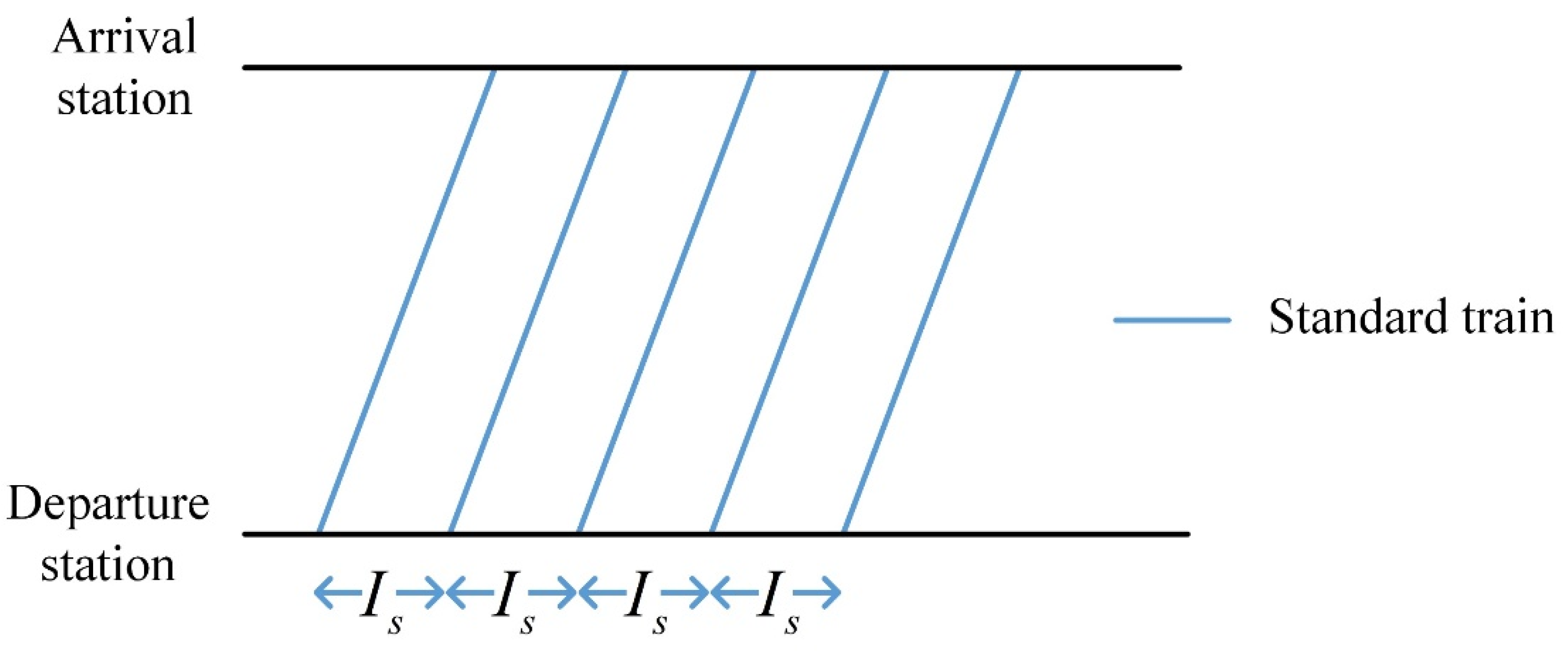

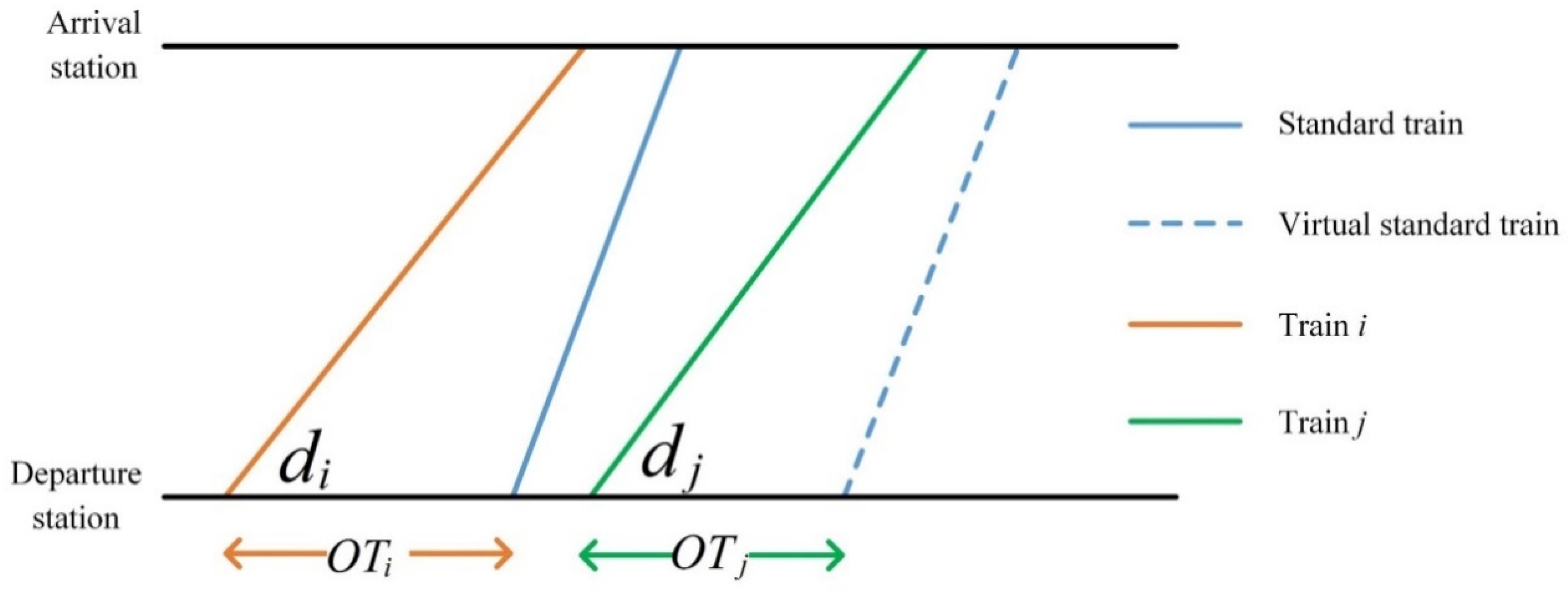
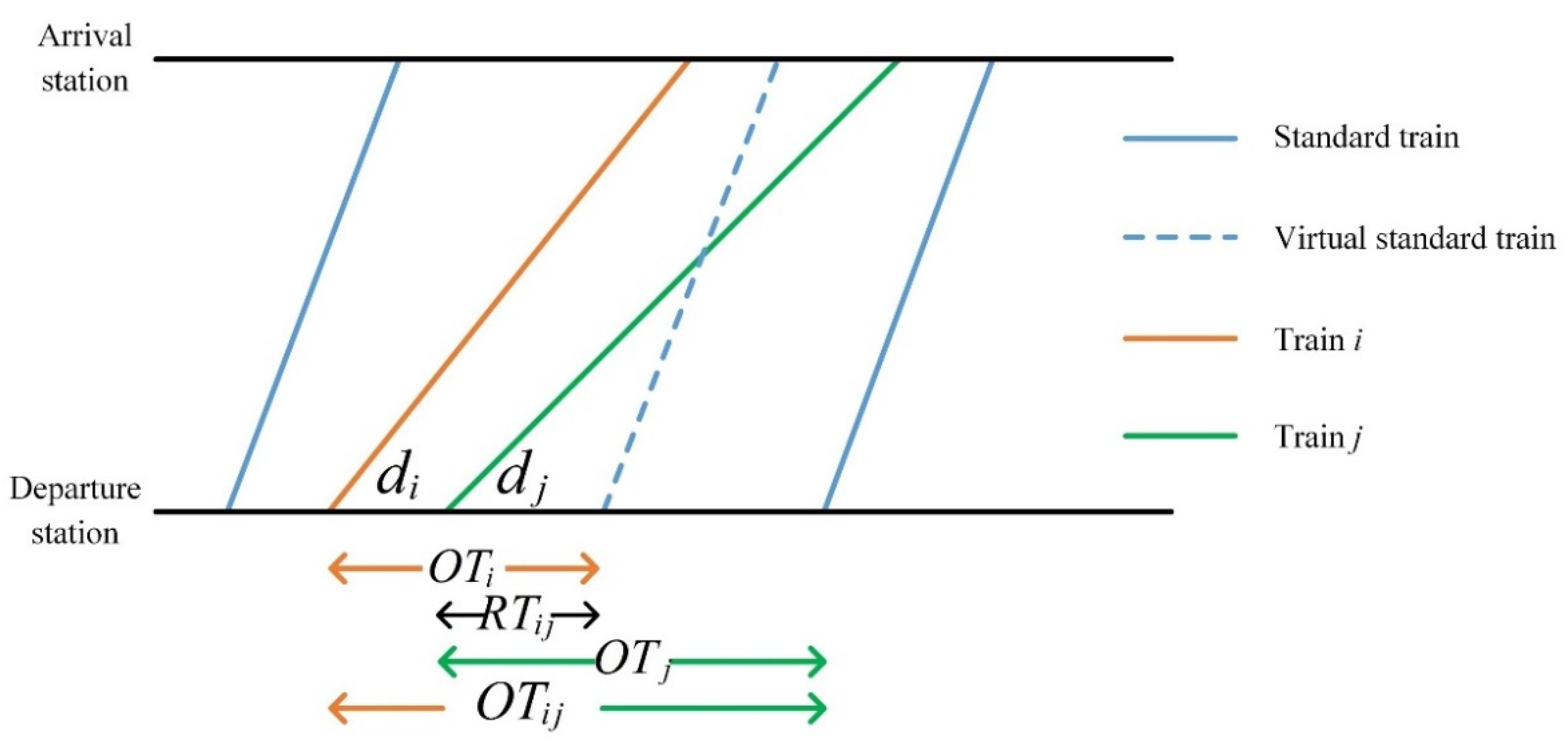


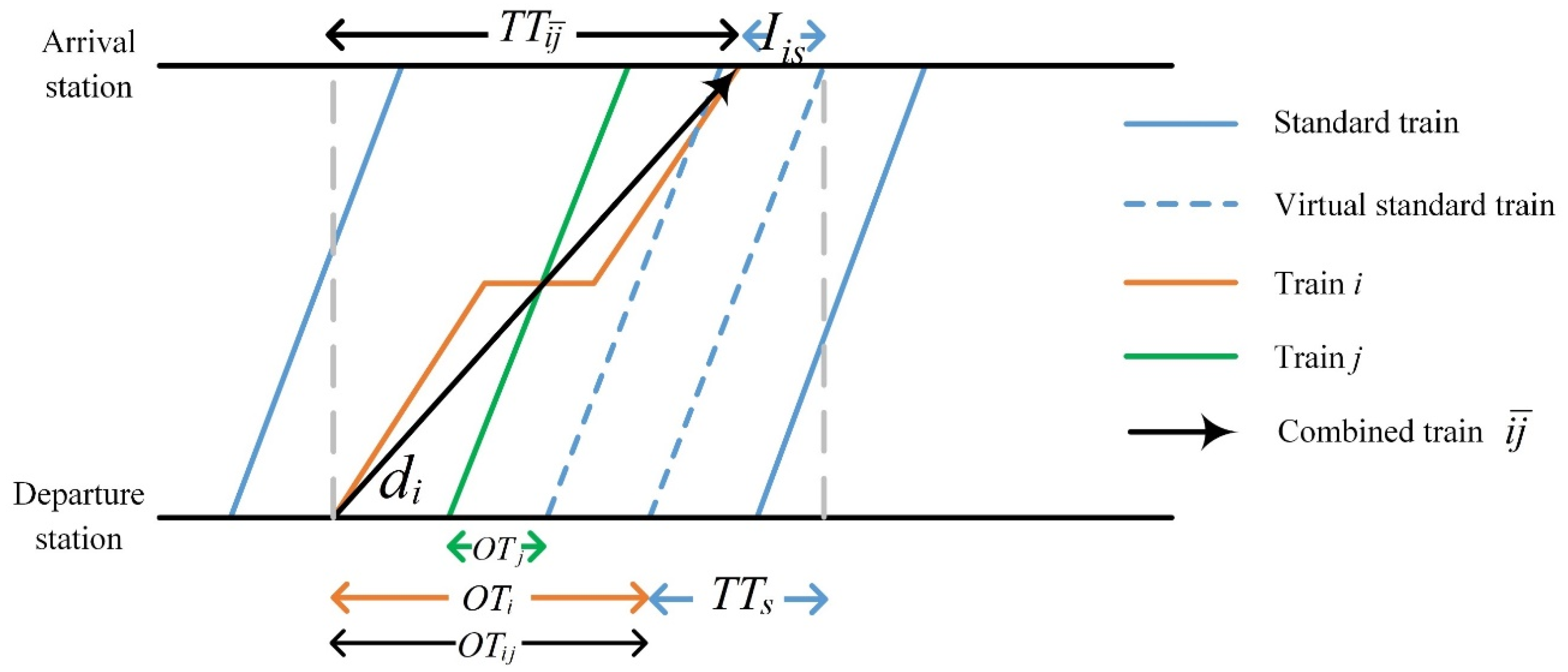
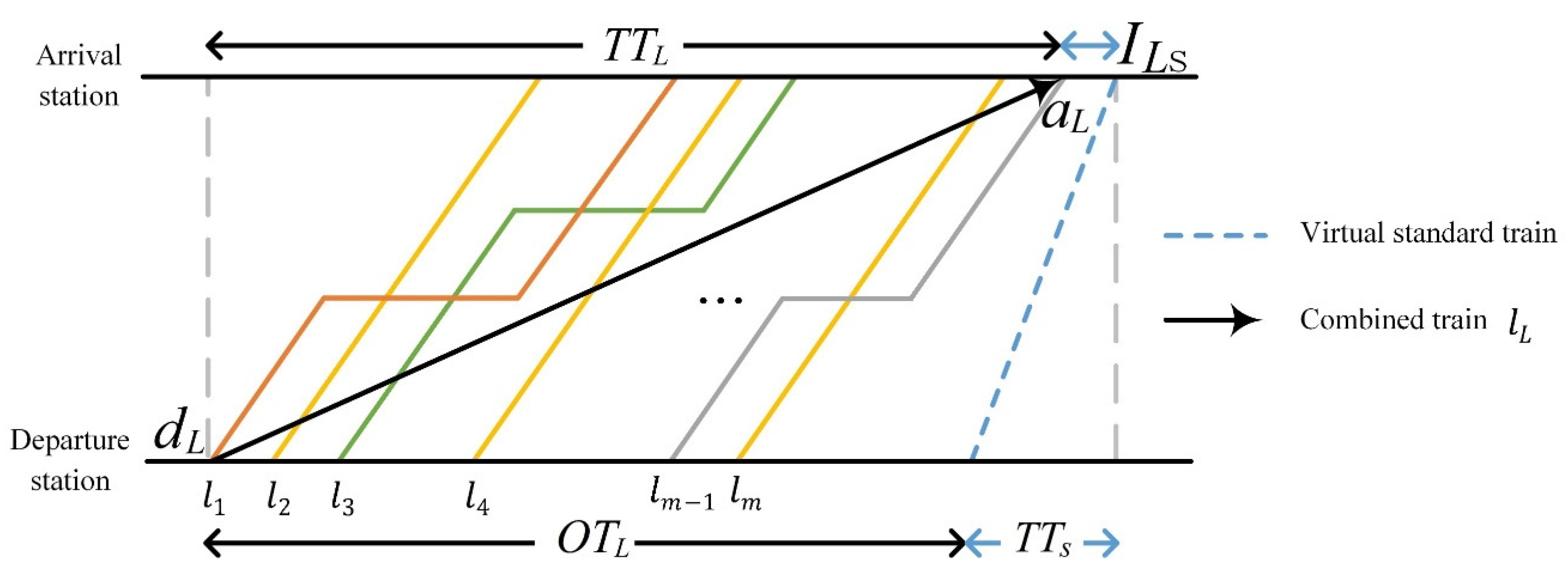
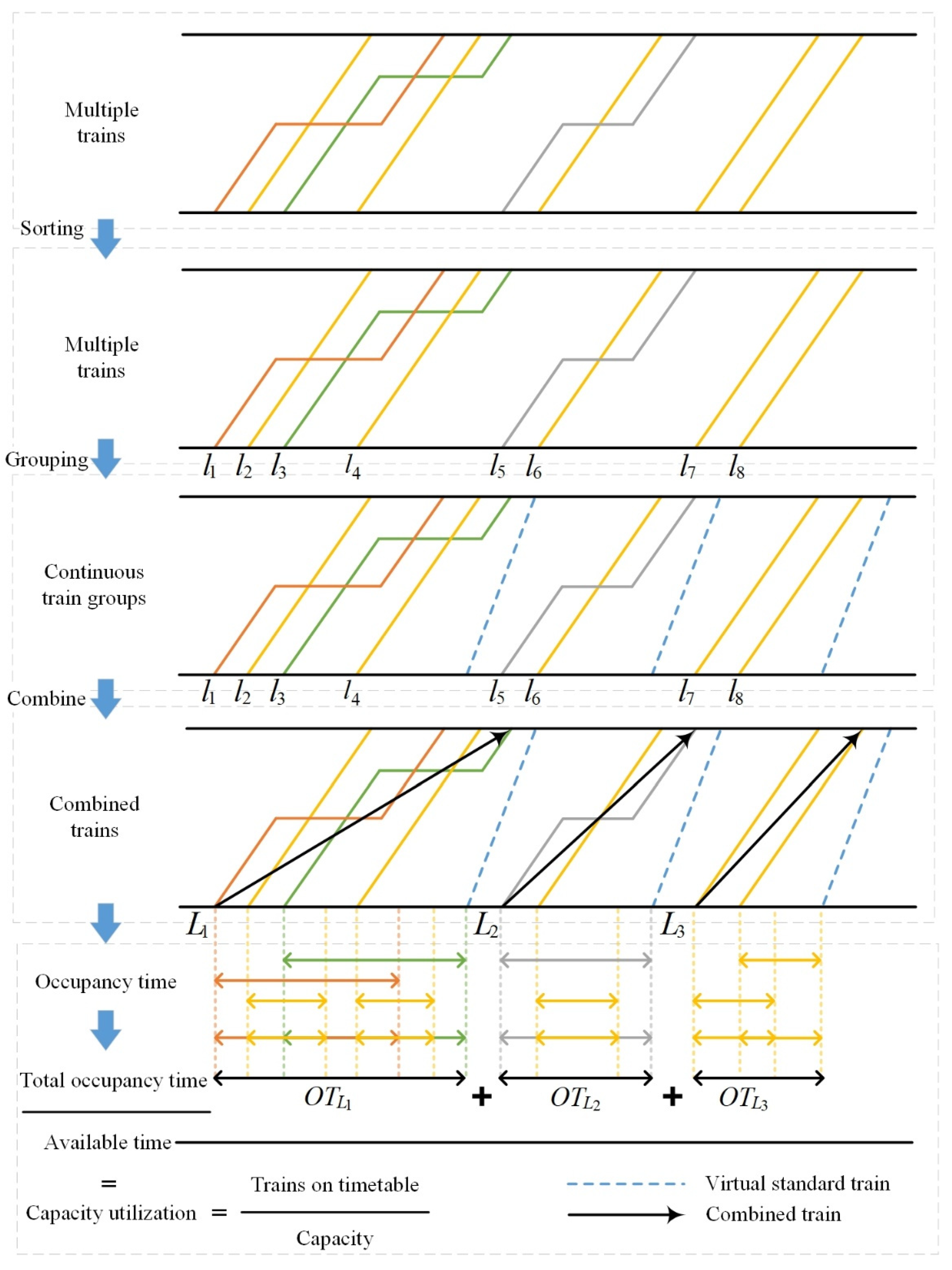
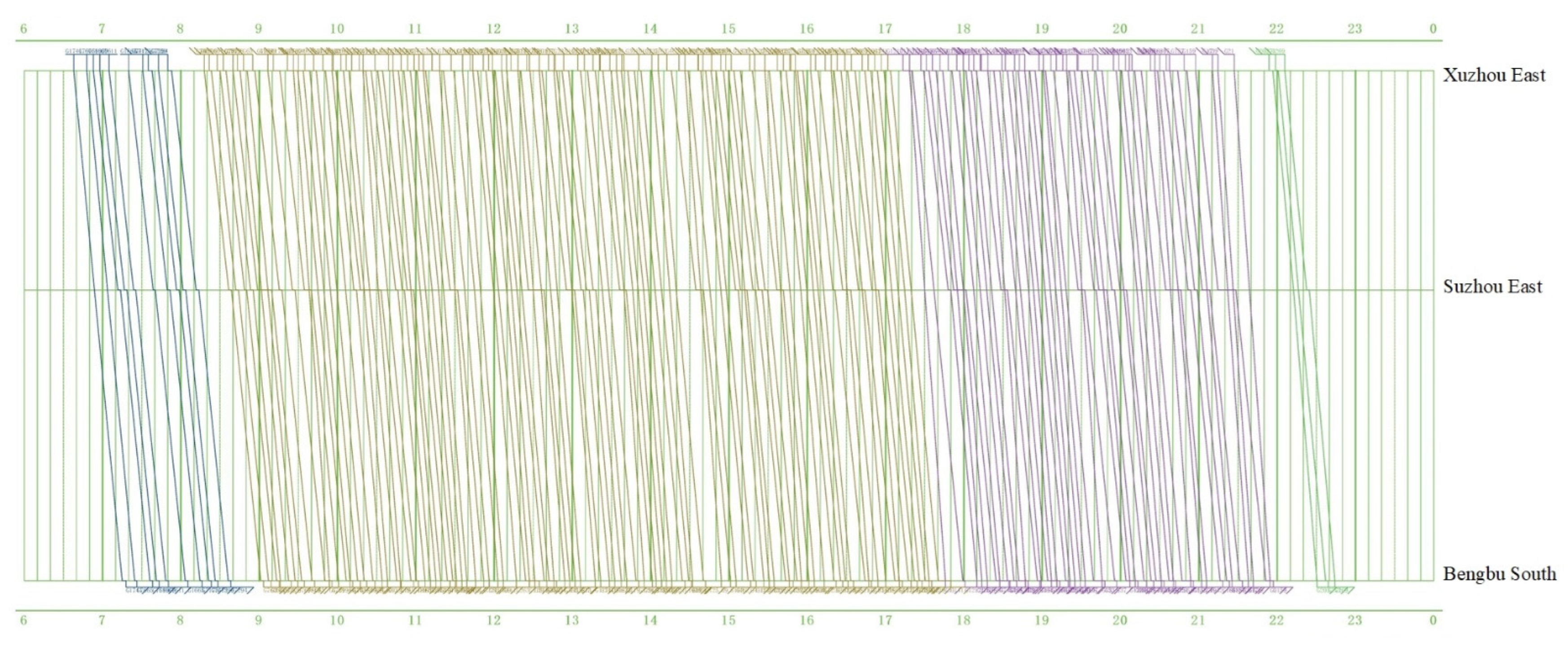
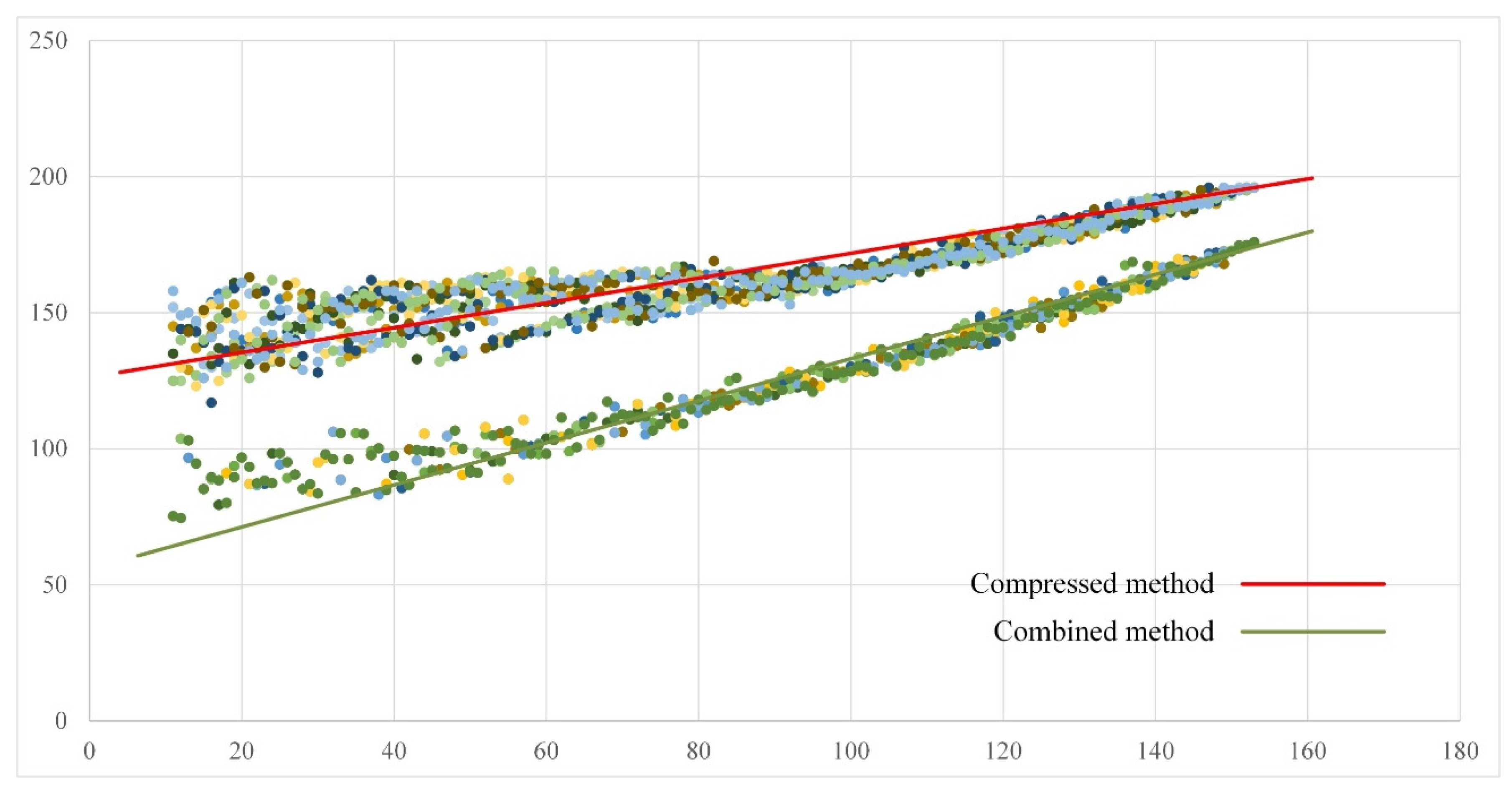
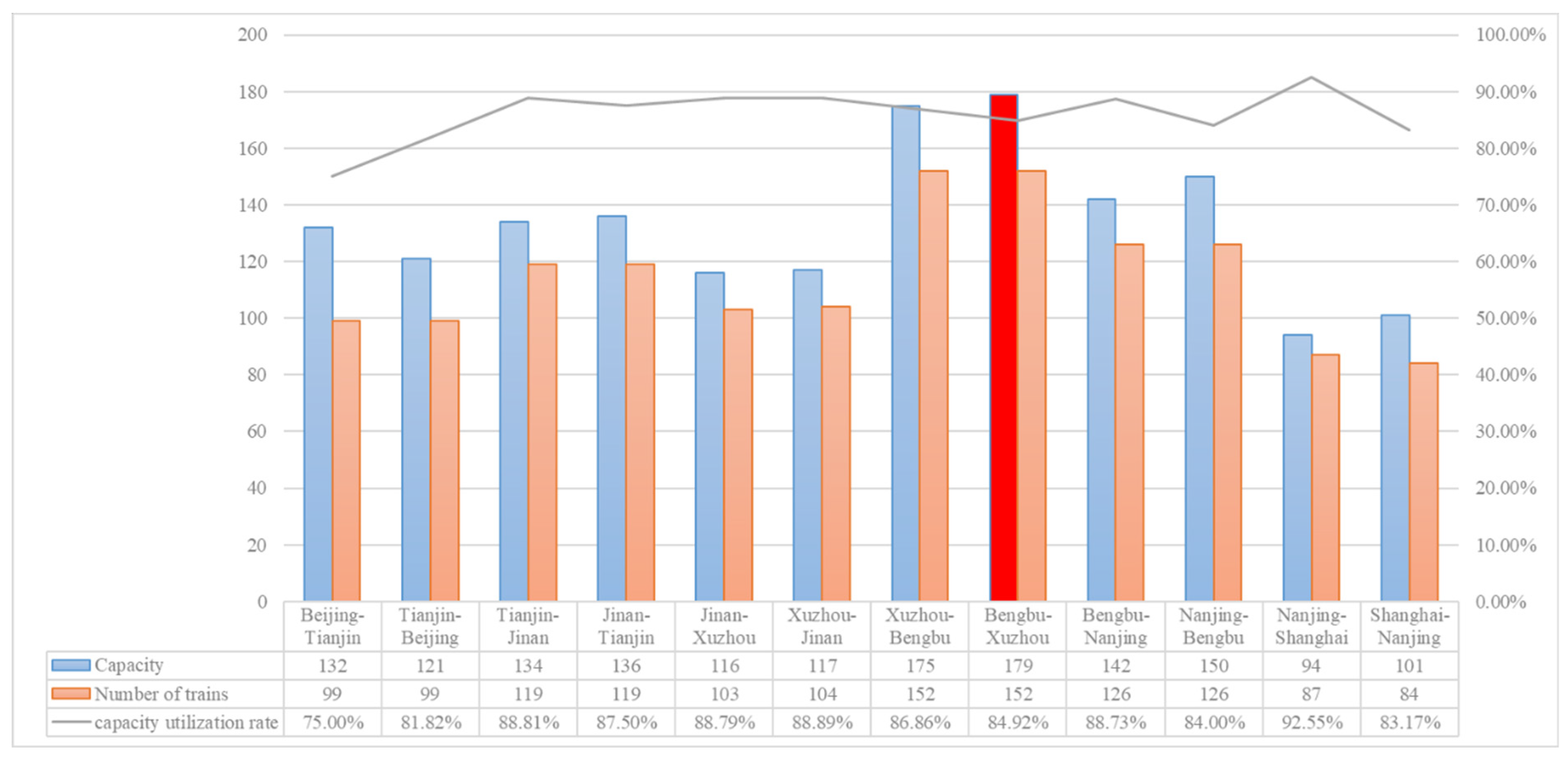
| Area | Method | Type | Disadvantage |
|---|---|---|---|
| Russia and China | Deduction coefficient method | Timetable independent | Lack of accuracy |
| Germany | Average minimum headway | Timetable independent | Lack of accuracy |
| France | UIC method | Timetable dependent | Timetable structure is changed |
| Sections | Departure Station | Arrival Station | Number of Stations | Length (km) | TTs |
|---|---|---|---|---|---|
| Beijing–Tianjin | Beijing South | Tianjin South | 3 | 131 | 0:26:40 |
| Tianjin–Jinan | Tianjin South | Jinan West | 4 | 288 | 0:51:10 |
| Jinan–Xuzhou | Jinan West | Xuzhou East | 6 | 269 | 0:50:45 |
| Xuzhou–Bengbu | Xuzhou East | Bengbu South | 3 | 156 | 0:27:20 |
| Bengbu–Nanjing | Bengbu South | Nanjing South | 4 | 174 | 0:34:00 |
| Nanjing–Shanghai | Nanjing South | Shanghai Hongqiao | 8 | 284 | 0:55:05 |
| Train Number | Combined Method | Compressed Method | ||||
|---|---|---|---|---|---|---|
| Capacity (Train) | Utilization (%) | Time (Millisecond) | Capacity (Train) | Utilization (%) | Time (Millisecond) | |
| 12 | 68.04201 | 17.63616 | 1 | 139.503 | 8.601963 | 8 |
| 17 | 75.61408 | 22.48258 | 1 | 142.0265 | 11.9696 | 13 |
| 22 | 75.71078 | 29.05795 | 1 | 146.5738 | 15.0095 | 20 |
| 27 | 76.13036 | 35.46548 | 1 | 138.6552 | 19.47277 | 29 |
| 32 | 83.87782 | 38.15073 | 1 | 142.6136 | 22.43825 | 43 |
| 37 | 89.77105 | 41.21596 | 1 | 141.5286 | 26.14313 | 50 |
| 42 | 92.55827 | 45.37682 | 1 | 145.3067 | 28.90437 | 69 |
| 47 | 93.7921 | 50.11083 | 1 | 142.048 | 33.0874 | 83 |
| 52 | 98.09211 | 53.0114 | 1 | 145.08 | 35.84231 | 111 |
| 57 | 102.5325 | 55.59215 | 1 | 147.0517 | 38.76187 | 132 |
| 62 | 105.4452 | 58.79829 | 2 | 154.1944 | 40.20899 | 154 |
| 67 | 105.8671 | 63.28689 | 2 | 154.1891 | 43.45313 | 188 |
| 72 | 111.7794 | 64.4126 | 5 | 157.7193 | 45.65073 | 232 |
| 77 | 115.2828 | 66.79227 | 2 | 158.1053 | 48.70171 | 273 |
| 82 | 116.1107 | 70.62223 | 2 | 161.1425 | 50.88664 | 310 |
| 87 | 119.7986 | 72.62191 | 2 | 165.4698 | 52.57758 | 358 |
| 92 | 124.4505 | 73.92495 | 3 | 169.0342 | 54.42685 | 402 |
| 97 | 122.9509 | 78.89329 | 3 | 175.3691 | 55.31191 | 520 |
| 102 | 123.3122 | 82.71691 | 3 | 174.5319 | 58.44205 | 552 |
| 107 | 119.1761 | 89.78309 | 4 | 173.2807 | 61.74953 | 625 |
| 112 | 124.1583 | 90.20741 | 6 | 176.3674 | 63.5038 | 679 |
| 117 | 133.7191 | 87.49683 | 4 | 179.0275 | 65.35307 | 822 |
| 122 | 138.571 | 88.04148 | 5 | 175.3167 | 69.58835 | 877 |
| 127 | 142.9265 | 88.85687 | 5 | 176.444 | 71.97752 | 982 |
| 132 | 154.1513 | 85.63015 | 5 | 177.4271 | 74.39677 | 1133 |
| 137 | 162.3803 | 84.36985 | 5 | 180.5965 | 75.85972 | 1216 |
| 142 | 166.4326 | 85.31982 | 5 | 186.487 | 76.14471 | 1312 |
| 147 | 170.0711 | 86.43445 | 5 | 190.44 | 77.18968 | 1441 |
| 152 | 175.5503 | 86.58486 | 9 | 193.1537 | 78.69379 | 2416 |
Publisher’s Note: MDPI stays neutral with regard to jurisdictional claims in published maps and institutional affiliations. |
© 2022 by the authors. Licensee MDPI, Basel, Switzerland. This article is an open access article distributed under the terms and conditions of the Creative Commons Attribution (CC BY) license (https://creativecommons.org/licenses/by/4.0/).
Share and Cite
Chen, A.; Chen, J.; Zhang, X. Train Occupancy Time of a Railway Section and the Combined Occupancy Method for Capacity Assessment. Appl. Sci. 2022, 12, 8132. https://doi.org/10.3390/app12168132
Chen A, Chen J, Zhang X. Train Occupancy Time of a Railway Section and the Combined Occupancy Method for Capacity Assessment. Applied Sciences. 2022; 12(16):8132. https://doi.org/10.3390/app12168132
Chicago/Turabian StyleChen, Angyang, Junhua Chen, and Xingchen Zhang. 2022. "Train Occupancy Time of a Railway Section and the Combined Occupancy Method for Capacity Assessment" Applied Sciences 12, no. 16: 8132. https://doi.org/10.3390/app12168132
APA StyleChen, A., Chen, J., & Zhang, X. (2022). Train Occupancy Time of a Railway Section and the Combined Occupancy Method for Capacity Assessment. Applied Sciences, 12(16), 8132. https://doi.org/10.3390/app12168132





